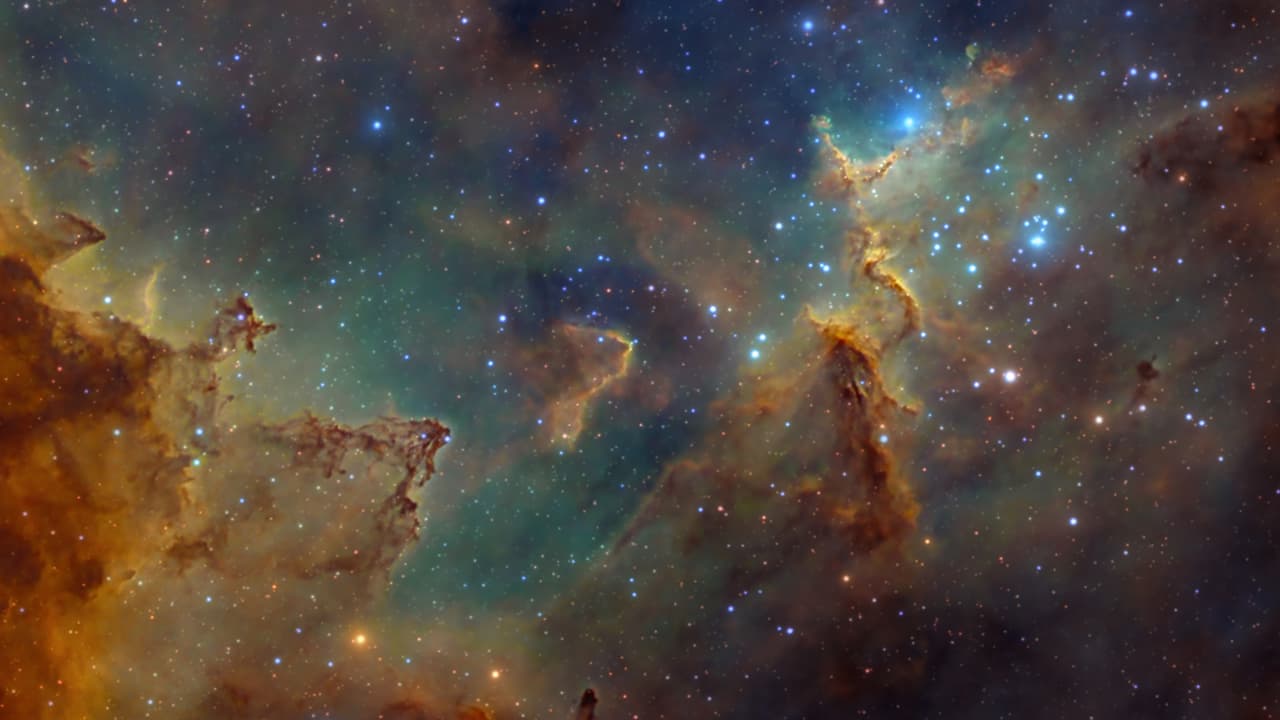Science
Scientists Uncover Hidden Sulfur in Cosmic Ice, Solving Mystery

Researchers have potentially resolved a longstanding enigma regarding the scarcity of sulfur in space. A recent study indicates that sulfur is not absent but is instead concealed within icy dust grains, forming complex structures that evade detection by telescopes. This discovery offers fresh insights into cosmic chemistry and the formation of stars and planets.
The Mystery of Missing Sulfur
For decades, scientists have grappled with the question of sulfur’s absence in the universe. On Earth, sulfur is abundant, found in oceans, released by volcanic activity, and integral to life itself. As the tenth most common element in the cosmos, sulfur plays a crucial role in the development of stars, planets, and living organisms. Yet, when astronomers examine vast clouds of gas and dust—regions where stars are born—they observe sulfur concentrations thousands of times lower than theoretical predictions.
This discrepancy has left researchers puzzled, with many pondering the reasons behind the apparent deficiency of this essential element.
New Insights from Astrochemists
A collaborative team of astrochemists from the University of Mississippi, University of Hawaii, and Georgia State University has proposed a solution. Their study, published in Nature Communications, suggests that sulfur may be hiding in plain sight within the icy depths of space. In these frigid environments, sulfur atoms can attach themselves to frozen dust grains, taking on complex molecular forms.
Two notable configurations identified are:
- Sulfur crowns (S8)—eight sulfur atoms linked in a ring resembling a crown.
- Polysulfanes—chains of sulfur atoms bonded with hydrogen.
These unusual forms do not emit the easily detectable signals that astronomers typically rely on to identify elements like oxygen and carbon, making sulfur particularly elusive.
“It never maintains the same shape,” explained Ryan Fortenberry, an astrochemist at the University of Mississippi. “It’s kind of like a virus—as it moves, it changes.”
Testing the Theory
To validate their hypothesis, the research team recreated interstellar conditions in a laboratory setting. By simulating icy environments akin to those found in space, they demonstrated that sulfur-rich molecules can form and remain stable on frozen dust grains. This indicates that the sulfur previously thought to be missing may simply be locked within ice, awaiting the right conditions to be released back into space.
Significance of the Discovery
Understanding sulfur’s behavior in the cosmos has implications that extend beyond mere academic interest. It could enhance our comprehension of stellar and planetary formation, as well as the origins of life. Furthermore, the study of sulfur in space can inform our understanding of planetary chemistry, both within our solar system and in distant galaxies.
Sulfur’s chemistry also affects life on Earth, influencing issues ranging from air pollution to ocean acidity. Gaining insights into its cosmic role can help scientists better understand its environmental impacts.
With this new roadmap, astronomers are encouraged to search for these hidden molecular shapes in star-forming regions. Future observations with advanced instruments, such as the James Webb Space Telescope, may finally unveil the true abundance of sulfur in the universe, confirming that this elusive element has simply been concealed in ever-changing icy forms.
-

 World5 months ago
World5 months agoSBI Announces QIP Floor Price at ₹811.05 Per Share
-

 Lifestyle5 months ago
Lifestyle5 months agoCept Unveils ₹3.1 Crore Urban Mobility Plan for Sustainable Growth
-

 Science4 months ago
Science4 months agoNew Blood Group Discovered in South Indian Woman at Rotary Centre
-

 World5 months ago
World5 months agoTorrential Rains Cause Flash Flooding in New York and New Jersey
-

 Top Stories5 months ago
Top Stories5 months agoKonkani Cultural Organisation to Host Pearl Jubilee in Abu Dhabi
-

 Sports4 months ago
Sports4 months agoBroad Advocates for Bowling Change Ahead of Final Test Against India
-

 Science5 months ago
Science5 months agoNothing Headphone 1 Review: A Bold Contender in Audio Design
-

 Top Stories5 months ago
Top Stories5 months agoAir India Crash Investigation Highlights Boeing Fuel Switch Concerns
-

 Business5 months ago
Business5 months agoIndian Stock Market Rebounds: Sensex and Nifty Rise After Four-Day Decline
-

 Sports4 months ago
Sports4 months agoCristian Totti Retires at 19: Pressure of Fame Takes Toll
-

 Politics5 months ago
Politics5 months agoAbandoned Doberman Finds New Home After Journey to Prague
-

 Top Stories5 months ago
Top Stories5 months agoPatna Bank Manager Abhishek Varun Found Dead in Well









